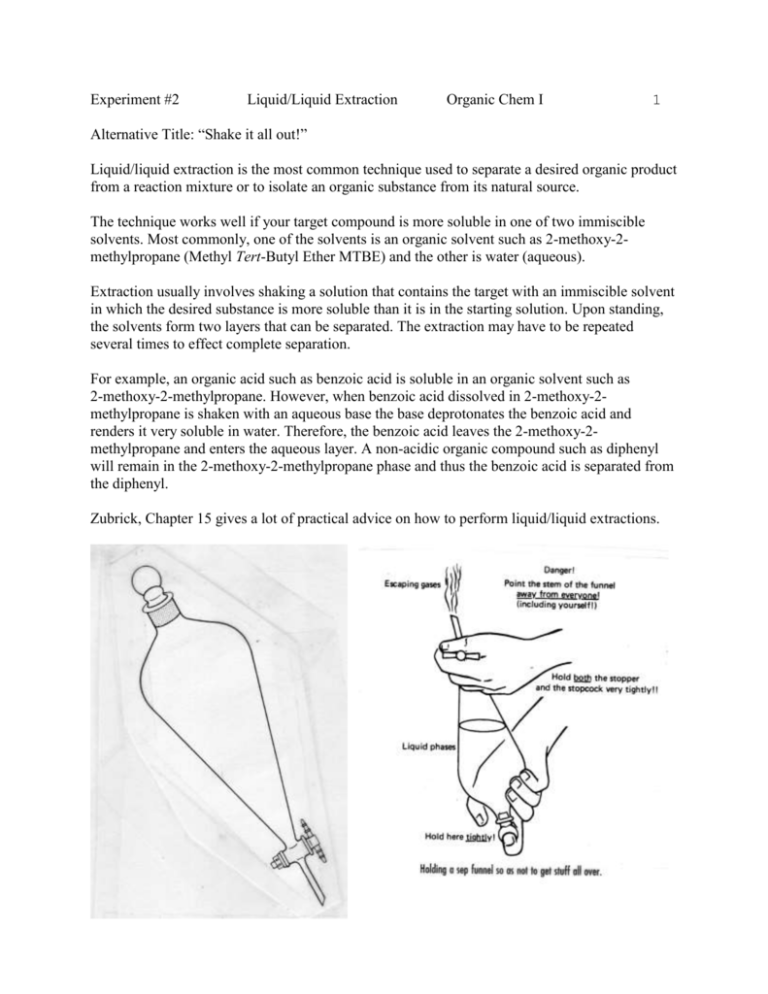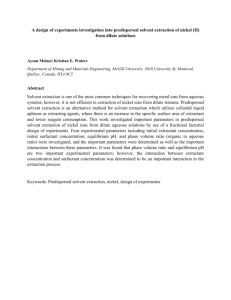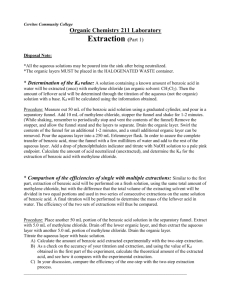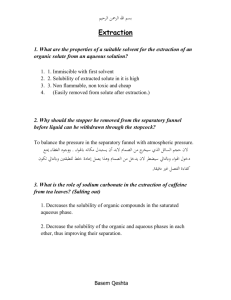Experiment #2 Liquid/Liquid Extraction
advertisement

Experiment #2 Liquid/Liquid Extraction Organic Chem I 1 Alternative Title: “Shake it all out!” Liquid/liquid extraction is the most common technique used to separate a desired organic product from a reaction mixture or to isolate an organic substance from its natural source. The technique works well if your target compound is more soluble in one of two immiscible solvents. Most commonly, one of the solvents is an organic solvent such as 2-methoxy-2methylpropane (Methyl Tert-Butyl Ether MTBE) and the other is water (aqueous). Extraction usually involves shaking a solution that contains the target with an immiscible solvent in which the desired substance is more soluble than it is in the starting solution. Upon standing, the solvents form two layers that can be separated. The extraction may have to be repeated several times to effect complete separation. For example, an organic acid such as benzoic acid is soluble in an organic solvent such as 2-methoxy-2-methylpropane. However, when benzoic acid dissolved in 2-methoxy-2methylpropane is shaken with an aqueous base the base deprotonates the benzoic acid and renders it very soluble in water. Therefore, the benzoic acid leaves the 2-methoxy-2methylpropane and enters the aqueous layer. A non-acidic organic compound such as diphenyl will remain in the 2-methoxy-2-methylpropane phase and thus the benzoic acid is separated from the diphenyl. Zubrick, Chapter 15 gives a lot of practical advice on how to perform liquid/liquid extractions. Experiment #2 Liquid/Liquid Extraction 2 Organic Chem I A flow chart of this procedure may be represented like this: O O C HO Ph-Ph OH benzoic acid O O Na NaHCO3, sodium bicarbonate diphenyl water, H2O 2-methoxy2-methylpropane Benzoic Acid Diphenyl 2-methoxy-2methylpropane Sodium Bicarbonate Water Shake it up Diphenyl 2-methoxy-2methylpropane Carbonic Acid Sodium Benzoate Water Carbonic Acid Water O Diphenyl 2-methoxy-2-methylpropane O Na sodium benzoate Experiment #2 Liquid/Liquid Extraction 3 Organic Chem I In general liquid-liquid extractions can separate four different classes of compounds: 1.) Organic bases: An organic amine can be extracted from an organic solvent with a strong acid such as 1M hydrochloric acid. NH 2 NH 3 Cl + HCl aniline - an organic base 2.) Strong acids: Carboxylic acids can be extracted from an organic solvent with a weak base such as 1M sodium bicarbonate. (See previous page.) 3.) Weak acids: Phenols can be extracted from an organic solvent with a strong base such as 1M sodium hydroxide. OH O + NaOH phenol - a weak acid 4.) Nonpolar compounds stay in the organic layer. Zubrick pp. 124-127 covers important information on gravity filtration. Na + H2O Experiment #2 Liquid/Liquid Extraction Organic Chem I 4 In this experiment you will separate the two components of your unknown mixture by liquid/liquid extraction. In other words you will use their different solubilities in two immiscible liquids to separate them. The goal of the experiment, in addition to gaining a familiarity with the technique of liquid-liquid extraction and what can be accomplished with it, is to recover the two components as nearly quantitatively as possible. With care, the actual extraction can be carried out quantitatively. Sample is usually lost in filtration, recrystallization, etc., but this can be minimized with good technique. Discarding the wrong phase or mislabeling more often loses samples. Be certain you check which is the aqueous layer either by checking the relative densities of solvents or by testing to see which layer dissolves a few added drops of water. Nitrile Gloves are Strongly Advised for this Experiment! Procedure: 1. Put distilled water in your separatory funnel, shake it and check for leaks. Check to make sure the stopcock is tight and functions properly. 2. Obtain the mass of your unknown mixture. You will use all of it for this experiment. 3. Dissolve your unknown mixture in 70 mL MTBE. This is solution A1. 4. Pour the mixture into a separatory funnel that is mounted on your ring stand. Be sure the stopcock is closed before you pour. 5. Obtain 45 mL of 1M Hydrochloric Acid (HCl). 6. Pour 15 mL of 1M HCl into the separatory funnel. Two layers should form. Which layer is the aqueous? 7. Shake the sep funnel vigorously with your finger on the stopper. Open the stopcock periodically to vent the vapor pressure build up. 8. Put the sep funnel back on the ring stand. Take off the stopper. Open the stopcock and drain only the lower layer into a beaker. 9. Repeat steps 6,7 and 8 with two more 15 mL portions of 1M HCl. 10. Save and combine the aqueous extracts after each extraction (solution B). 11. Leave the organic (solution A2) layer in the separatory funnel. 12. Repeat steps 5. through 9. with 45 mL of 1M Sodium Bicarbonate solution. It is critical to shake the separatory funnel well in this step. 13. Save and combine the aqueous extracts after each extraction (solution C). Experiment #2 Liquid/Liquid Extraction Organic Chem I 5 14. Leave the organic (solution A3) layer in the separatory funnel. 15. Repeat steps 5. through 9. with 45 mL of 1M Sodium Hydroxide. 16. Save and combine the aqueous extracts after each extraction (solution D). 17. Pour the MTBE layer (A4) into a properly labeled jar. 18. Let your MTBE solution sit uncovered in the hood to slowly evaporate the MTBE (and a little water) and leave any residue that is present. Two of the 4 solutions (A4, B, C and D) contain your unknowns. 19. Bascify soltuion B with 10M NaOH. Use pH indicator paper. 20. Acidify solutions C and D with 10M HCl. Use pH indicator paper. Part II. Recovering your Unknown from Aqueous Extracts: The formation of a precipitate is an indication that your unknown is found in a solution. If a precipitate forms, chill the extract in an ice and water bath. Recover the precipitate by gravity filtration. Let the recovered crystals dry in the hood until next week. Place the wet solid and filter paper in a beaker or jar so the air current in the hood will not scatter the solid once it dries. Save your recovered solids for Experiment #3! Obtain the mass of your solids next week and complete the lab report. Note: When working with compounds whose thermal and chemical stability is unknown to you, as a matter of principle treat the samples as gently as possible. In the present experiment, avoid boiling solutions to dryness on the steam bath. Remove residual solvent at room temperature. When adding concentrated acid or base to the aqueous extracts mix the solutions adequately during addition to avoid localized high concentrations of acid or base, which might cause undesired transformations of the sample. Waste Disposal: Put all MTBE waste solutions in the appropriate waste bottle. All liquid wastes go into the liquid waste container. Wear gloves and clean up all your spills with paper towels. Experiment #2 Liquid/Liquid Extraction Organic Chem I Checklist for completing the "Prelab" section: (refer to Laboratory Syllabus for complete directions) ____ Read through the appropriate section of the syllabus. ____ Title. ____ (1) Purpose. Physical constants. Complete table of physical constants and safety data: Name Formula M.W. m.p. oC b.p. oC Density g/mole g/mL MTBE C5H12O 88.15 -109 55.2 0.741 2-methoxy-2methylpropane Aqueous Hydrochloric Acid Aqueous Sodium Hydroxide Aqueous Sodium Bicarbonate Name MTBE 2-methoxy-2methylpropane Aqueous Hydrochloric Acid Aqueous Sodium Hydroxide Aqueous Sodium Bicarbonate References: HCl 36.5 1M sol. ~0 1M sol. ~100 1 M sol. ~1.0 NaOH 40.0 1M sol ~0 1M sol. ~100 1 M sol. ~1.0 NaHCO3 84.0 1M sol ~0 1M sol. ~100 1 M sol. ~1.0 Solubility Safety Information immiscible w/ water, misc w/ Volatile Vapors are noxious. alc and nonpolar solvents Flammable sol in water, sol in alcohol insol in nonpolar solvents Highly toxic. Corrosive and irritating to skin, eyes and mucous membranes. sol in water, sol in alc, insol in nonpolar solvents Corrosive and irritating to skin, eyes and mucous membranes. Avoid skin contact sol in water, sol in alc, insol in nonpolar solvents Weak base. Produces carbon dioxide upon contact with acid. 1) Merck Index, 11th ed. 2) www.chemfinder.com 3) Hazardous Chemical Desk Reference, Lewis and Sax, 1987 4) Aldrich catalog online 6 Experiment #2 Liquid/Liquid Extraction Organic Chem I Structures and equations. (2 points) Draw complete structures and balanced equations for: 7 ___ The Bronsted-Lowry Acid/Base reaction of 4-chloroaniline with H+ Cl-. ___ The Bronsted-Lowry Acid/Base reaction of benzoic acid with Na+ HCO3___ The Bronsted-Lowry Acid/Base reaction of 2-naphthol with Na+ -OH. ___ (1) Flowchart. Refer to "Procedure" ___ Calculations. 1) (1 point) Solvent B extracts 80% of your target compound from Solvent A. You start with 10 g of target compound in Solvent A. a) How much target compound is left in Solvent A after you extract it once with Solvent B? b) How much target compound is left in Solvent A after you extract it twice with Solvent B? c) How much target compound is left in Solvent A after you extract it thrice with Solvent B? 2) (1 point) Refer to the possible unknowns in the Lab Handout 1. Which unknowns would you expect to extract into which phase (A4, B, C, D)? A4 B C D benzoic acid cinnamic acid 4-methoxyphenol 1,4-dibromobenzene acetanilide 4-chloroaniline 2-methoxynaphthalene 2-naphthol 3’-aminoacetophenone Read through the student comments from previous years. http://ochemonline.pbworks.com/Introductory+Sequence:+Liquid-Liquid+Extraction _____(1) Which one do you find most helpful? Safety Question: (1 point) While you are venting the separatory funnel with MTBE and 1M sodium bicarbonate (step 12) some of the vapor gets in your eye. What should you do immediately after realizing this exposure? What could have been done to prevent this accident? Experiment #2 Liquid/Liquid Extraction 8 Organic Chem I Experimental Observations and Data: Experiment #2 Hand in a copy of your experimental observations and data before you leave lab. (4 points) Experimental Observations. ___ Did you record the mass of the unknown mixture? ___ What is the appearance of the dissolved unknown mixuture? ___ What does the first separation look like for A1/B? ___ What does the first separation look like for A2/C? ___ What does the first separation look like for A3/D? ___ How much NaOH did you have to add to bascify the aqueous acid extracts B? ___ How did the appearance of the solution change when you added base? ___ How much HCl did you have to add to acidify the aqueous acid extracts C? ___ How did the appearance of the solution change when you added acid? ___ How much HCl did you have to add to acidify the aqueous base extracts D? ___ How did the appearance of the solution change when you added acid? ___ Any blunders to report? Did you get the layers mixed up? ___ Did you record interesting sights and smells? ___ What did the recovered crystals look like? Lab Report Checklist: Experiment #2 Results. ____ (2 points) Table of solutions (A4,B,C,D) with your observations. A4 B C Molarity and XXXXXXXX volume of base/acid XXXXXXXX needed to neutralize Appearance after XXXXXXXX neutralization XXXXXXXX Mass of precipitate (g) % recovery from unknown mixture. Additional comments D Experiment #2 Liquid/Liquid Extraction Organic Chem I 9 Discussion and Conclusion. ____ (1) Which of the following statements represent advantages of the liquid/liquid extraction technique? Indicate all correct answers. a. b. c. d. e. f. Large or small quantities of compound can be separated. Two compounds that you want to separate may have similar solubility characteristics With care, the actual extraction can be carried out nearly quantitatively. Sometimes compounds can be recrystallized directly from their extract. If you know the structure of your target compound you can often predict its solubility. Organic solvents are used that may be harmful to the environment. ____ (1) Which of the following statements represent disadvantages of the liquid/liquid extraction technique? Indicate all correct answers. a. b. c. d. e. f. Large or small quantities of compound can be separated. Two compounds that you want to separate may have similar solubility characteristics With care, the actual extraction can be carried out nearly quantitatively. Sometimes compounds can be recrystallized directly from their extract. If you know the structure of your target compound you can often predict its solubility. Organic solvents are used that may be harmful to the environment. ____ (1) Why do we do extractions three times and not only once? Refer to Preb Calculations. ____ (1) Why do we do extractions three times and not five or more? ____ (1) Refer to Question (2) on the Prelab. What can you conclude about the identities of your unknowns as a result of this experiment? ____ (1) MTBE has been used as a gasoline additive for the past few years. What have been two environmental consequences of this practice? Refer to http://pubs.usgs.gov/fs/fs10501/ Include one additional reference. Neither death, nor life, nor angels, nor principalities, nor powers, nor things present, nor things to come, Nor height, nor depth, nor any other creature, shall be able to separate us from the love of God. Bible, Romans 8:38





